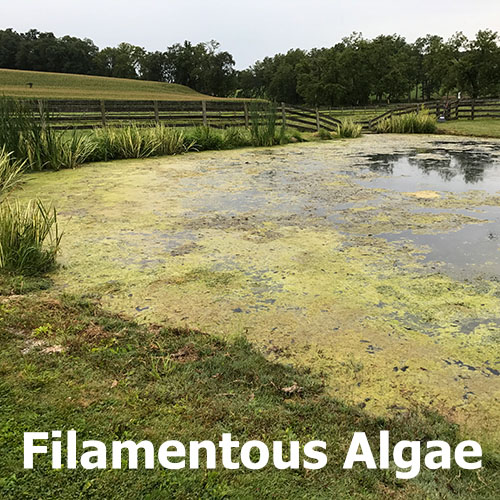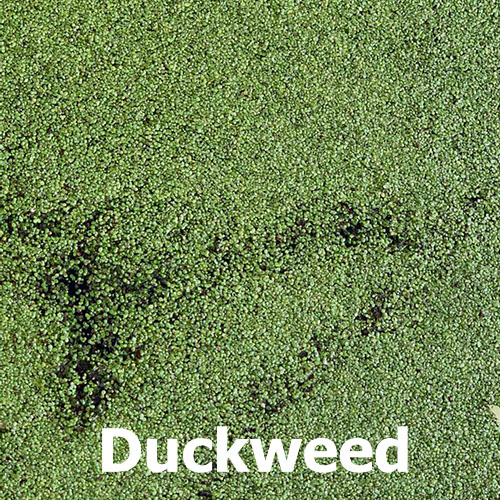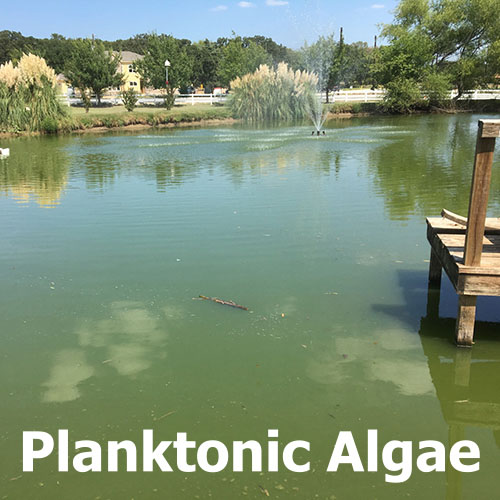Green Algae and Pond Scum
What is Pond Scum?
Green slime, moss, surface scum, stringy snot - Many words used to describe algae growth. Besides algae, duckweed and watermeal can also fall into this description of surface scum.
What is algae?
Algae is a microorganism that lacks a stem, root, or leaves.
Why is algae growing in my pond?
Algae growth can occur in ponds where there are nutrients and sunlight available. The two nutrients that are associated with algae growth are Nitrogen and Phosphorus.
Is algae a bad thing?
Algae is a sign that there are pond nutrients present. In high enough concentrations these can pose health risks. Some algae is okay. Algae provides food to small aquatic critters at the bottom of the pond's food chain. A pond that is overtaken by algae can cause problems with fish, and other wildlife that use the pond.
Is Duckweed the same as Algae?
Duckweed is actually an aquatic weed that is often confused with algae. This can very quickly cover the entire surface of the pond. Natural treatments do not impact growth of duckweed.



What are the best pond scum treatment options?
There are two directions to take when managing ALGAE
1.Chemicals- Kill existing growth. The liquid Algaecides with treatment catalysts yield the fastest results. For long=term control use a dry algaecide like Cutrine Granular Algaecide for extended algae control.
2.Natural treatments- Manage nutrients present in water. Nutrient management products include Muck Remover, Pond Cleanse, and Phosphate Eliminator. Each of these treatments serves a different purpose. Muck Remover consumes nutrient-rich sludge at the bottom of the pond. Good bacteria in Pond Cleanse packets break down nitrate, nitrite and ammonia that is suspended in water. Phosphate Eliminator targets phosphate in water.
Both of these options are effective. A combination of chemicals and natural treatments is an excellent way to achieve both short-term satisfaction, and long-term control. Chemical algaecide treatment yields immediate satisfaction. Follow up with natural treatments to consume dying algae and other nutrients that cause blooms.
For treatment of DUCKWEED & WATERMEAL
For ponds with little outflow Propeller aquatic herbicide. For ponds with moderate flow, use Duckweed Destroyer Pack. This fast acting herbicide combination can be used to treat the entire pond or spot treat as growth begins.
What if you have a combination of string algae and duckweed or watermeal? The Duckweed Destroyer Pack effectively kills algae as well as the floating weeds.
Are these treatments applied once or on a routine basis?
This varies based on the condition of the pond. Ponds with high nutrient loads may require multiple chemical treatments per year. Others that have low nutrients may only need one chemical treatment to suppress the growth. Nutrients are constantly being introduced in the pond by fish, birds, dead vegetation, etc. Typically natural treatments are applied every 2 weeks, and continued each year.
One step further:
Water quality testing is a way to gain better insight to what is happening in your pond. What nutrients are present? Is there something going on that you can't see? The water quality report included with your nutrient findings gives you guidance on the next steps.
Before you treat your pond, here are a few additional facts about algae:
- Forms of filamentous(string algae) begin their life at the bottom of the pond
- As the algae cells begin to die, they become buoyant and float to the surface
- Algae produces oxygen during the day, but consumes oxygen at night
- When algae dies, it consumes oxygen
- Aeration improves the effectiveness of natural treatments
